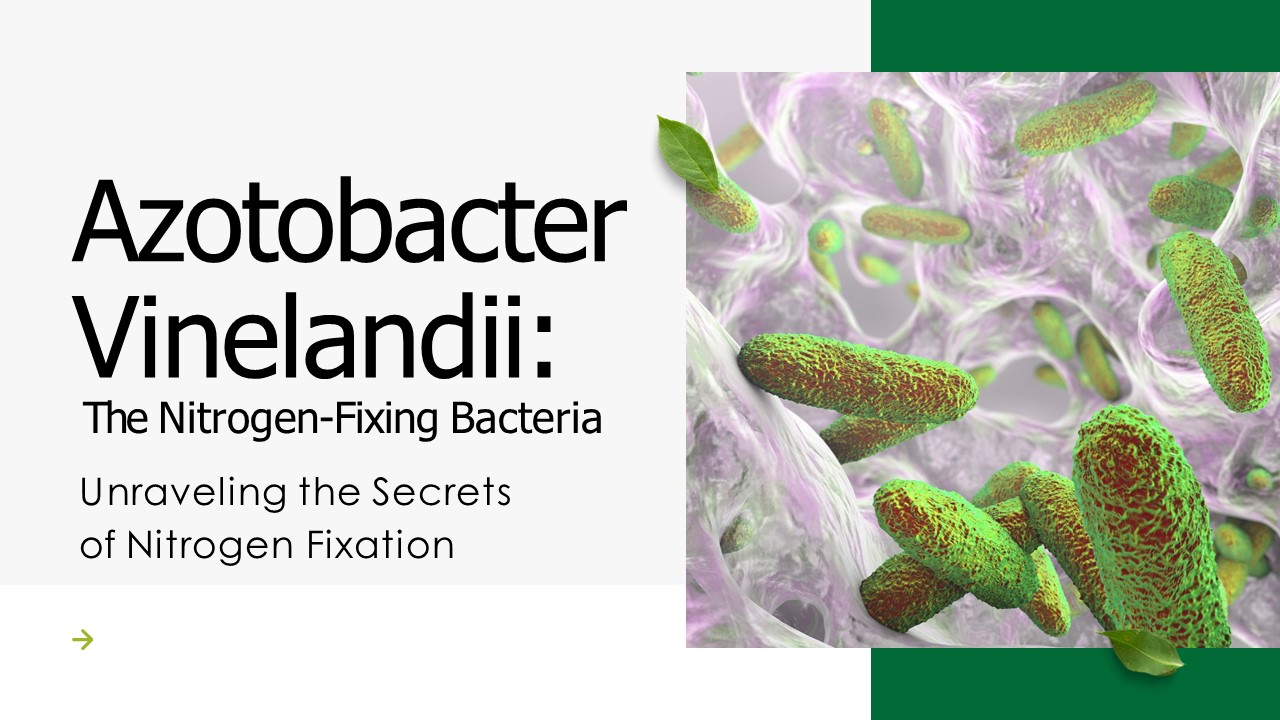Uses of Azotobacter Vinelandii in Modern Farming PowerPoint PPT Presentation
Title: Uses of Azotobacter Vinelandii in Modern Farming
1
Azotobacter
Vinelandii
The Nitrogen-Fixing Bacteria Unraveling the
Secrets of Nitrogen Fixation
2
Introduction
Nitrogen is a vital element for plant growth,
essential for proteins, DNA, and chlorophyll.
Nitrogen-fixing bacteria play a crucial role in
making atmospheric nitrogen accessible to
plants. Azotobacter Vinelandii, a remarkable
nitrogen-fixing bacterium, holds the key to
enhanced soil fertility and agricultural
productivity.
3
What is Azotobacter Vinelandii?
Azotobacter Vinelandii is a free-living,
nitrogen- fixing bacterium found in soil. It's
characterized by its ability to convert
atmospheric nitrogen (N2) into ammonia (NH3), a
form usable by plants. This bacterium thrives in
various environments, making it a versatile
nitrogen fixer.
4
Nitrogen Fixation
Nitrogen fixation is the process by which
atmospheric nitrogen is converted into ammonia.
During this process, Azotobacter Vinelandii uses
nitrogenase enzymes to break the strong N2 bonds.
Ammonia produced is readily absorbed by plants
and used for growth.
5
Azotobacter Vinelandii's Role in Agriculture
Azotobacter Vinelandii forms a symbiotic
relationship with plant roots. It helps in
nitrogen fixation, making nitrogen available to
plants. This natural process enhances soil
fertility, promoting healthy plant growth.
6
Benefits of Azotobacter Vinelandii
- The use of Azotobacter Vinelandii in agriculture
offers several advantages. It improves soil
structure, increasing water and nutrient
retention. - Reduced reliance on synthetic fertilizers lowers
environmental impact.
7
Cultivation of Azotobacter Vinelandii
Azotobacter Vinelandii can be cultivated under
specific conditions. It thrives in aerobic
conditions with pH levels around 7. Proper
nutrient supply and temperatures between 25-30C
are essential for its growth.
8
Application Methods
Azotobacter Vinelandii can be applied through
various methods. Seed treatment involves coating
seeds with the bacterium.
Soil application and foliar spraying are
effective ways to introduce it into the growing
environment.
9
Environmental
Impact The use of Azotobacter Vinelandii in
agriculture reduces environmental pollution.
Lower synthetic fertilizer use means less runoff
into water bodies.
It contributes to sustainable and eco- friendly
farming practices.
10
CHALLENGES AND CONSIDERATIONS
While beneficial, Azotobacter Vinelandii requires
careful consideration. Compatibility with other
agricultural practices is crucial. Monitoring and
quality control are essential to ensure its
effectiveness.
11
CASE STUDIES
Explore successful applications of Azotobacter
Vinelandii in agriculture. Highlight instances
where crop yields and soil fertility were
significantly improved.
12
Future Prospects
Ongoing research seeks to improve the efficiency
of Azotobacter Vinelandii. Innovations in
sustainable agriculture may further harness its
potential. The future holds promise for increased
agricultural productivity and reduced
environmental impact.
13
CONCLUSION
Azotobacter Vinelandii is a key player in
nitrogen fixation, essential for plant
growth. Its application in agriculture benefits
soil fertility and crop yields. Harnessing its
potential contributes to sustainable and
eco-friendly farming practices.
14
THANKS YOU
FOR YOUR ATTENTION

